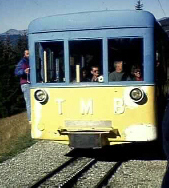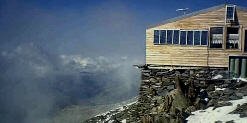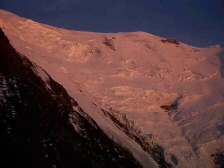Mont Blanc -- Refuge Tête Rousse
 We
got up Sunday morning and drove to a tram that ferried passengers
from Les Houches to Bellevue, a restaurant and chalet at 5900
feet. This tram is also used for skiing in the winter. Next to
Bellevue is a small cog-rail train station. We boarded the train
which took us to le Nid d'Aigle at 7780 feet. From there, we began
hiking.
We
got up Sunday morning and drove to a tram that ferried passengers
from Les Houches to Bellevue, a restaurant and chalet at 5900
feet. This tram is also used for skiing in the winter. Next to
Bellevue is a small cog-rail train station. We boarded the train
which took us to le Nid d'Aigle at 7780 feet. From there, we began
hiking.
Philippe and I were amazed at how small everyone else's packs
were. We were carrying heavy packs complete with bivouac gear
and food for 3-4 days. It turns out that the other people were
doing the standard route and did not need sleeping bags or food
since everything was provided at Refuge de l'Aiguille du Goûter.
We were also carrying some hardware such as ice screws, a snow
fluke, and a shovel. Of course, we also carried a rope which we
made continuous use of above Refuge Aiguille du Goûter. Even
though the route was mostly glacier, and had some steep, exposed
sections, many of the climbers we saw were unroped.
Anyway, a little above le Nid d'Aigle, at about 8800 feet, I saw
a family of chamois. These are antelope-like animals with spiked
horns. Apparently, chamois are fairly rare and I was lucky to
see them.
 After
three hours of hiking up the ridge leading up Aiguille du Goûter,
I arrived at a point near Refuge de Tête Rousse at 10,400
feet where Philippe had been waiting for about 20 minutes. With
the heavy pack and high altitude, and just plain weeniness, I
was dragging butt. Our original plan was to push it to Refuge
Aiguille du Goûter that day, then get up in the wee hours
for a push to the summit. Since the forecast was for good weather
at least through Tuesday, I convinced Philippe that we should
spend a night at Refuge Tête Rousse for rest and acclimatization.
After
three hours of hiking up the ridge leading up Aiguille du Goûter,
I arrived at a point near Refuge de Tête Rousse at 10,400
feet where Philippe had been waiting for about 20 minutes. With
the heavy pack and high altitude, and just plain weeniness, I
was dragging butt. Our original plan was to push it to Refuge
Aiguille du Goûter that day, then get up in the wee hours
for a push to the summit. Since the forecast was for good weather
at least through Tuesday, I convinced Philippe that we should
spend a night at Refuge Tête Rousse for rest and acclimatization.
At Tête Rousse, we made friends with a local girl named
Françoise. Her friends (or so she thought) were moving fast up
to Refuge Aiguille du Goûter, leaving her behind, so she
decided to stay at Refuge Tête Rousse. We made arrangements
to meet her in Chamonix later in the week, which we did three
days later.
 The
sleeping arrangements at Refuge Tête Rousse were typical
of the many refuges throughout the Alps. The dormitory style bunks
were comfortable and blankets were provided (although were had
our sleeping bags with us). The cost was a little less than $20,
and a hot meal was provided for about $20. From Tête Rousse
we had great views of Glacier de Bionnassay and the 13,300 feet
Aiguille de Bionnassay. Refuge Tête Rousse is the starting
point for a climb of Aiguille de Bionnassay.
The
sleeping arrangements at Refuge Tête Rousse were typical
of the many refuges throughout the Alps. The dormitory style bunks
were comfortable and blankets were provided (although were had
our sleeping bags with us). The cost was a little less than $20,
and a hot meal was provided for about $20. From Tête Rousse
we had great views of Glacier de Bionnassay and the 13,300 feet
Aiguille de Bionnassay. Refuge Tête Rousse is the starting
point for a climb of Aiguille de Bionnassay.
Click here to continue…
 We
got up Sunday morning and drove to a tram that ferried passengers
from Les Houches to Bellevue, a restaurant and chalet at 5900
feet. This tram is also used for skiing in the winter. Next to
Bellevue is a small cog-rail train station. We boarded the train
which took us to le Nid d'Aigle at 7780 feet. From there, we began
hiking.
We
got up Sunday morning and drove to a tram that ferried passengers
from Les Houches to Bellevue, a restaurant and chalet at 5900
feet. This tram is also used for skiing in the winter. Next to
Bellevue is a small cog-rail train station. We boarded the train
which took us to le Nid d'Aigle at 7780 feet. From there, we began
hiking. After
three hours of hiking up the ridge leading up Aiguille du Goûter,
I arrived at a point near Refuge de Tête Rousse at 10,400
feet where Philippe had been waiting for about 20 minutes. With
the heavy pack and high altitude, and just plain weeniness, I
was dragging butt. Our original plan was to push it to Refuge
Aiguille du Goûter that day, then get up in the wee hours
for a push to the summit. Since the forecast was for good weather
at least through Tuesday, I convinced Philippe that we should
spend a night at Refuge Tête Rousse for rest and acclimatization.
After
three hours of hiking up the ridge leading up Aiguille du Goûter,
I arrived at a point near Refuge de Tête Rousse at 10,400
feet where Philippe had been waiting for about 20 minutes. With
the heavy pack and high altitude, and just plain weeniness, I
was dragging butt. Our original plan was to push it to Refuge
Aiguille du Goûter that day, then get up in the wee hours
for a push to the summit. Since the forecast was for good weather
at least through Tuesday, I convinced Philippe that we should
spend a night at Refuge Tête Rousse for rest and acclimatization.
 The
sleeping arrangements at Refuge Tête Rousse were typical
of the many refuges throughout the Alps. The dormitory style bunks
were comfortable and blankets were provided (although were had
our sleeping bags with us). The cost was a little less than $20,
and a hot meal was provided for about $20. From Tête Rousse
we had great views of Glacier de Bionnassay and the 13,300 feet
Aiguille de Bionnassay. Refuge Tête Rousse is the starting
point for a climb of Aiguille de Bionnassay.
The
sleeping arrangements at Refuge Tête Rousse were typical
of the many refuges throughout the Alps. The dormitory style bunks
were comfortable and blankets were provided (although were had
our sleeping bags with us). The cost was a little less than $20,
and a hot meal was provided for about $20. From Tête Rousse
we had great views of Glacier de Bionnassay and the 13,300 feet
Aiguille de Bionnassay. Refuge Tête Rousse is the starting
point for a climb of Aiguille de Bionnassay.